Sony HVR-Z5U, HVR-Z5N User Manual

http://www.sony.net/
Printed on 70% or more recycled paper using VOC (Volatile Organic Compound) -free vegetable oil based ink.
Printed in Japan
US Recorder Camera Video HD Digital
4-114-857-11(1)
Digital HD Video
Camera Recorder
Operating Guide
Before operating the unit, please read this manual thoroughly, and retain it for future reference
HVR-Z5U/Z5N
© 2008 Sony Corporation
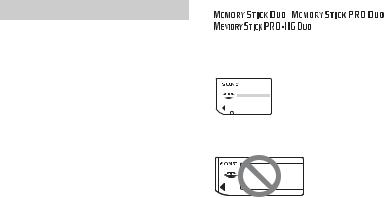
Read this first
Before operating this unit, please read this manual thoroughly, and retain it for future reference.
Notes on use
Types of cassette you can use in your camcorder
Your camcorder is capable of recording in HDV, DVCAM and DV formats.
When recording in HDV/DV format, Sony recommends that you use mini DV cassettes.
When recording in DVCAM format, Sony recommends that you use mini DVCAM cassettes. Your camcorder does not support the Cassette Memory function (p. 119).
The HDV format
•Digital high-definition (HD) video signals are recorded and played back on a DV format cassette.
•HDV signals are compressed in MPEG2 format, which is adopted in BS (broadcast satellite) digital and terrestrial digital HDTV broadcastings and in Blu-ray disc recorders.
Types of “Memory Stick” you can use in your camcorder
You can use any “Memory Stick” that has the following markings.
“Memory Stick Duo”
(This size can be used with your camcorder.)
“Memory Stick”
(You cannot use it in your camcorder.)
b Notes
•You cannot use any type of memory card except “Memory Stick Duo.”
•“Memory Stick PRO Duo” can be used only with “Memory Stick PRO” compatible equipment.
•Do not attach a label or the like on a “Memory Stick Duo” or a “Memory Stick Duo” Adaptor.
•When using a “Memory Stick Duo” with “Memory Stick” compatible equipment, insert the “Memory Stick Duo” into the “Memory Stick Duo” Adaptor.
2

Using the camcorder
•Do not hold the camcorder by the following part.
Lens hood |
LCD panel |
|
|
|
|
|
|
|
Internal microphone Microphone or Microphone holder
Viewfinder
b Notes
•The camcorder is not dustproof, dripproof or waterproof.
See “About handling of your camcorder” (p. 125).
•Do not connect cables to your camcorder with their terminals placed the wrong way. Squeezing the terminals into your camcorder's jacks may damage them or results in a malfunction of your camcorder.
About menu items, LCD panel, viewfinder, and lens
•A menu item that is grayed out is not available under the current recording or playback conditions.
•The LCD screen and the viewfinder are manufactured using extremely highprecision technology, so over 99.99% of the pixels are operational for effective use. However, there may be some tiny black points and/or bright points (white, red, blue, or green in color) that appear constantly on the LCD screen and the viewfinder. These points are normal results of the manufacturing process and do not affect the recording in any way.
Black point
White, red, blue or green point
Do not expose your camcorder’s viewfinder, lens, or LCD screen to the sun or strong light source for extended periods.
•Intense light sources, especially the sun will converge on the viewfinder or lens and damage the internal parts of your camcorder. Avoid sunlight or other strong light sources when storing your camcorder. Protect this device by always closing the lens cover or by placing it in its bag when not in use.
About temperature of your camcorder and battery pack
•Your camcorder has a protective function that disables recording or playback if the temperature of your camcorder or battery
Continued , 3

Read this first (Continued)
pack is beyond the safely operable range. In this case, a message appears on the screen or in the viewfinder (p. 116).
On recording
•Before starting to record, test the recording function to make sure the picture and sound are recorded without any problems.
•Compensation for the contents of recordings cannot be provided, even if recording or playback is not possible due to a malfunction of the camcorder, storage media, etc.
•TV color systems differ depending on the countries/regions. To view your recordings on a TV, you need an NTSC system-based TV.
•Television programs, films, video tapes, and other materials may be copyrighted. Unauthorized recording of such materials may be contrary to the copyright laws.
•Because of the way that the image device (CMOS sensor) reads out image signals, the subjects passing by the frame rapidly might appear crooked depending on the recording conditions. This phenomenon may be notable in displays having high motion resolution.
On playing back HDV tapes on other devices
A tape recorded in the HDV format cannot be played back on a device that is not compatible with the HDV format.
Check the contents of tapes by playing them back on this camcorder prior to playing them back on other devices.
Notes on the icons used in this manual
 Features available for the HDV format only.
Features available for the HDV format only.
 Features available for the DVCAM format only.
Features available for the DVCAM format only.
 Features available for the DV SP format only.
Features available for the DV SP format only.


 The function that can be used when i.LINK cable is connected.
The function that can be used when i.LINK cable is connected.
 The function that can be assigned to an ASSIGN button.
The function that can be assigned to an ASSIGN button.
About this manual
•The images of the LCD screen and the viewfinder used in this manual for illustration purposes are captured using a digital still camera, and therefore may appear different.
•The on-screen displays in each local language are used for illustrating the operating procedures. Change the screen language before using your camcorder if necessary (p. 21).
•Design and specifications of recording media and other accessories are subject to change without notice.
•Illustrations of battery packs in this manual show the NP-F770 unless otherwise specified.
4

Table of Contents |
|
Read this first ........................................................................................... |
2 |
Getting Started |
|
Step 1: Checking supplied items .............................................................. |
8 |
Step 2: Attaching the supplied microphone and the lens hood with lens |
|
cover ........................................................................................... |
10 |
Step 3: Charging the battery pack .......................................................... |
13 |
Step 4: Turning the power on and holding your camcorder properly ..... |
17 |
Step 5: Adjusting the LCD panel and viewfinder .................................... |
18 |
Step 6: Setting the date and time ........................................................... |
20 |
Changing the language setting .......................................................... |
21 |
Step 7: Inserting a tape or a “Memory Stick Duo” .................................. |
22 |
Recording/Playback |
|
Recording ............................................................................................... |
24 |
Changing the settings of your camcorder recordings ............................. |
28 |
Adjusting the zoom ............................................................................. |
28 |
Adjusting the focus manually.............................................................. |
29 |
Adjusting the image brightness .......................................................... |
30 |
Adjusting to natural color (White balance).......................................... |
33 |
Customizing the picture quality (Picture profile)................................. |
35 |
Adjusting the volume .......................................................................... |
44 |
Attaching a Memory Recording Unit................................................... |
44 |
Assigning the functions to the ASSIGN buttons ..................................... |
46 |
Recording an index signal .................................................................. |
47 |
Playing back the most recently recorded movies |
|
(Last scene review)............................................................................. |
48 |
Reviewing the most recently recorded scenes (Rec review).............. |
48 |
Searching for the last scene of the most recent recording |
|
(End search) ....................................................................................... |
48 |
Using the Shot transition ..................................................................... |
48 |
Playback ................................................................................................. |
51 |
Changing/checking the settings in your camcorder ................................ |
54 |
Changing the screen .......................................................................... |
54 |
Displaying recording data (Data code) .............................................. |
54 |
Displaying the settings in your camcorder (Status check) ................. |
55 |
Checking the remaining battery (Battery Info).................................... |
55 |
Continued , 5
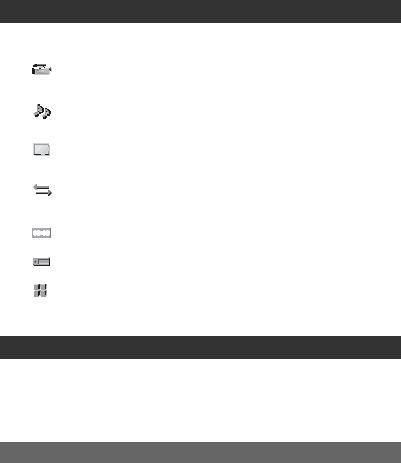
Table of Contents (Continued) |
|
Locating a scene on a tape .................................................................... |
56 |
Searching for a scene by date of recording (Date search) ................ |
56 |
Searching for a recording start point (Index search) .......................... |
56 |
Playing the picture on a TV .................................................................... |
58 |
Using the Menu |
|
Using the menu items ........................................................... |
64 |
Menu items ............................................................................................ |
66 |
(CAMERA SET) menu .................................................................... |
69 |
Settings to adjust your camcorder to the recording conditions (GAIN SETUP/ BACK LIGHT/STEADYSHOT, etc.)
(AUDIO SET) menu ....................................................................... |
77 |
Settings for the audio recording (DV AU.MODE (DV Audio mode)/XLR SET, etc.)
(DISPLAY SET) menu ..................................................................... |
80 |
Display settings of the display and the viewfinder (MARKER/VF B.LIGHT/DISP OUTPUT, etc.)
(IN/OUT REC) menu ....................................................................... |
85 |
Recording settings, input and output settings (REC FORMAT/HDV PROGRE./ VIDEO OUT/EXT REC CTRL, etc.)
(TC/UB SET) menu ......................................................................... |
89 |
(TC PRESET/UB PRESET/TC LINK, etc.) |
|
(MEMORY SET) menu .................................................................... |
91 |
Settings for the “Memory Stick Duo” (ALL ERASE/FORMAT, etc.) |
|
(OTHERS) menu ............................................................................. |
92 |
Settings while recording on a tape or other basic settings (QUICK REC/BEEP, etc.)
Dubbing/Editing |
|
Dubbing to VCR, DVD/HDD device, etc. |
............................................... 96 |
Recording pictures from a VCR .......................................................... |
100 |
Copying movies on a tape to a computer ............................................ |
102 |
Copying still images to a computer ...................................................... |
105 |
Troubleshooting |
|
Troubleshooting ................................................................................... |
106 |
Warning indicators and messages ....................................................... |
116 |
6

Additional Information |
|
Using your camcorder abroad .............................................................. |
118 |
Maintenance and precautions .............................................................. |
119 |
HDV format and recording/playback ................................................ |
119 |
Compatibility of the DVCAM/DV formats........................................... |
120 |
About the “Memory Stick” ................................................................. |
122 |
About the “InfoLITHIUM” battery pack ............................................. |
123 |
About i.LINK...................................................................................... |
124 |
About x.v.Color ................................................................................. |
125 |
About handling of your camcorder ................................................... |
125 |
Specifications ....................................................................................... |
129 |
Quick Reference |
|
Identifying parts and controls ............................................................... |
134 |
Indicators for the LCD screen and viewfinder ...................................... |
140 |
Index ..................................................................................................... |
143 |
7

Getting Started
Step 1: Checking supplied items
Make sure that you have following items supplied with your camcorder.
The number in the parentheses indicates the number of that item supplied.
•The cassette tape and “Memory Stick Duo” are not included. See pages 2, 119 and 122 for types of cassette tapes and “Memory Stick Duo” that you can use on your camcorder.
AC Adaptor/Charger (AC-VQ1050) (1) (p. 13)
Power cord (mains lead) (1) (p. 13)
Wireless Remote Commander (RMT-831)
(1) (p. 139)
Large eyecup (1) (p. 19)
Rechargeable battery pack (NP-F770) (1) (p. 13, 123)
(Only for models HVR-Z5U)
Rechargeable battery pack (NP-F570) (1) (p. 13, 123)
(Only for models HVR-Z5N)
Lens hood with lens cover (1) (p. 12)
This lens hood is pre-mounted.
A button-type lithium battery is already installed. |
Wind Screen (1), Microphone (ECM-XM1) |
|||||||||
|
|
|
|
|
|
|
|
|
|
(1) (p. 10) |
Component A/V cable (1) (p. 58) |
|
|||||||||
|
|
|
|
|
|
|
|
|
|
|
|
|
|
|
|
|
|
|
|
|
|
|
|
|
|
|
|
|
|
|
|
|
|
|
|
|
|
|
|
|
|
|
|
|
|
|
|
|
|
|
|
|
|
|
|
|
|
|
|
|
|
|
|
|
|
|
|
|
|
|
|
|
|
|
|
|
|
|
|
|
|
|
|
|
|
|
|
|
|
|
|
|
|
|
|
|
|
|
A/V connecting cable (1) (p. 58, 96)
8

Accessory shoe kit (Accessory shoe (1), Accessory shoe plate (1), screws (4)) (p. 134)
Connecting cord (DK-415) (1) (p. 15)
CD-ROM “Manuals for Digital HD Video Camera Recorder” (1)
Operating Guide (2)
Started Getting
9
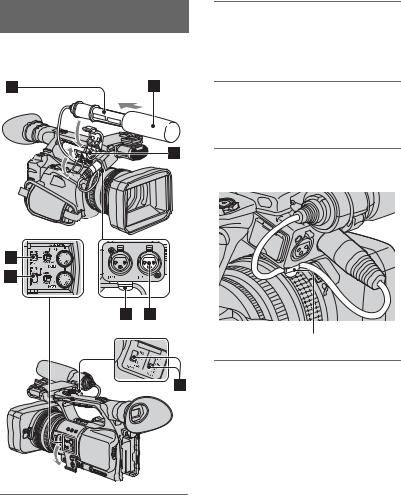
Step 2: Attaching the supplied microphone and the lens hood with lens cover
Attaching the supplied microphone
When you use the supplied microphone (ECM-XM1) for recording sound, do the following steps.
1 Attach the wind screen B to the supplied microphone A.
2 Place the microphone A in the microphone holder C with the model name facing upward, close the cover, and shut the clamp.
3 Connect the plug of the
microphone to the INPUT1 jack
D.
4 Put the microphone cable into the cable holder E.
Put the cable in the outer cable holder.
5 Select channels with the CH1 (INT MIC/INPUT1) switch F and the
CH2 (INT MIC/INPUT1/INPUT2) switch G.
See the table below for the recording channels.
10

When the CH1 switch is set to INT MIC
CH2 switch |
Input channel and source |
|
position |
|
|
INT MIC |
Internal |
|
|
microphone |
CH1 |
|
(L) |
|
|
Internal |
|
|
microphone |
CH2* |
|
(R) |
|
INPUT1 |
Internal |
|
|
microphone |
CH1 |
|
(mono) |
|
|
XLR INPUT1 |
CH2** |
INPUT2 |
Internal |
|
|
microphone |
CH1 |
|
(mono) |
|
|
XLR INPUT2 |
CH2** |
When the CH1 is set to INPUT1
CH2 switch |
Input channel and source |
|
position |
|
|
INT MIC |
XLR INPUT1 |
CH1 |
|
Internal |
|
|
microphone |
CH2** |
|
(mono) |
|
INPUT1 |
XLR INPUT1 |
CH1 |
|
|
CH2** |
INPUT2 |
XLR INPUT1 |
CH1 |
|
XLR INPUT2 |
CH2** |
*The recording level of channel 2 is synchronized with that of channel 1 when only the internal microphone is used. The recording level of channel 2 is controlled with the CH1 (AUDIO LEVEL) dial and the CH1 (AUTO/ MAN) switch.
**You can adjust the recording levels of channel 1 and channel 2 separately.
6 Set the INPUT1 switch H to an appropriate position for the microphone connected to the INPUT1 jack D.
LINE: For inputting sound from an audio device
MIC: For inputting sound from an external microphone that does not support the +48V power source.
MIC+48V: For inputting sound from a device that supports the +48V power source including the supplied microphone.
When you connect a microphone to the INPUT2 jack, set the INPUT2 switch to an appropriate position for that microphone.
b Notes
•When you connect a device that supports the +48V power source to the INPUT1 or INPUT2 jack, set the INPUT1/INPUT2 switch to MIC prior to connecting the device. When you disconnect the device, set the INPUT1/INPUT2 switch to MIC first, then disconnect it.
•When you connect a microphone that does not support the +48V power source to the INPUT1 or INPUT2 jack, set the INPUT1/INPUT2 switch to MIC. If you use it with the INPUT1/ INPUT2 switch set to MIC+48V, it may be damaged or the recorded sound may be distorted.
z Tips
• See page 44 for adjusting the volume.
Started Getting
Continued , 11
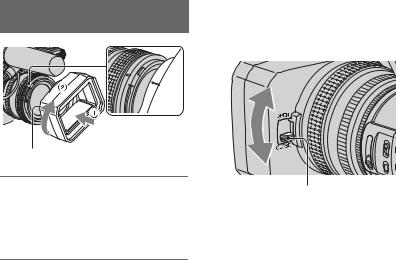
Step 2: Attaching the supplied microphone and the lens hood with lens cover (Continued)
Attaching the lens hood with lens cover
To open or close the shutter of the lens hood with lens cover
Move the lens cover lever up or down to open or close the lens cover.
PUSH (lens hood release) button
Align the marks on the lens hood to those on the camcorder, and turn the lens hood in the direction of the arrow 2.
Move the lens cover lever to OPEN to open the lens cover, and move the lever to CLOSE to close the lens cover.
To remove the lens hood with lens cover
Turn the lens hood in the opposite direction to the arrow 2 in the illustration while pressing the PUSH (lens hood release) button.
z Tips
•If you attach or remove a 72mm (2 7/8 in.) PL filter or MC protector, remove the lens hood with lens cover.
12

Step 3: Charging the battery pack
You can charge the “InfoLITHIUM” battery pack (L series) with the supplied AC Adaptor/Charger.
b Notes
•You cannot use batteries other than the “InfoLITHIUM” battery pack (L series) (p. 123).
2
3 
 4
4 

1
Charge lamp
1 Set the mode change switch to CHARGE.
2 Connect the power cord (mains lead) to the AC Adaptor/Charger.
3 Connect the power cord (mains lead) to the wall outlet (wall socket).
4 Place the battery pack in the slot of the AC Adaptor/Charger, press it down, and slide it in the direction of the arrow as illustrated.
The charge lamp turns on and charging starts.
After charging the battery
All segments of the battery mark (

 ) appear in the display window when the normal charge of the battery is completed. You can fully charge the battery pack if you continue charging the battery pack after the charge lamp turns off until the battery mark with “FULL” appears (full charge). The battery life of the fully charged battery is slightly longer than that of the normally charged battery.
) appear in the display window when the normal charge of the battery is completed. You can fully charge the battery pack if you continue charging the battery pack after the charge lamp turns off until the battery mark with “FULL” appears (full charge). The battery life of the fully charged battery is slightly longer than that of the normally charged battery.
Remove the battery pack from the AC Adaptor/Charger when the charge is completed.
z Tips
•You can check the remaining battery life with the battery info function (p. 55).
To attach the battery pack
Press the battery pack against the back of your camcorder and slide it down.
Started Getting
Continued , 13

Step 3: Charging the battery pack (Continued)
To remove the battery pack
Slide the POWER switch to OFF. Push the BATT RELEASE (battery release) button and remove the battery pack.
BATT RELEASE (battery release) button
To store the battery pack
If the battery pack will not be used for a while, run down the battery and store it. See page 124 for details on storage of the battery pack.
Charging time
Approximate time (min.) required when you fully charge a fully discharged battery pack.
Battery pack |
Charging time |
NP-F570 |
145 |
|
|
NP-F770 |
230 |
|
|
NP-F970 |
310 |
|
|
b Notes
•For HVR-Z5N*:
–The supplied battery pack is NP-F570.
–You cannot use the NP-F330 battery pack with your camcorder.
•For HVR-Z5U*:
–The supplied battery pack is NP-F770.
–You cannot use the NP-F330/F570 battery pack with your camcorder.
*You can find the model name at the bottom of your camcorder.
Recording time
Approximate time (min.) available when you use a fully charged battery pack.
Recording in the HDV format
Battery pack |
Continuous |
Typical |
|
recording |
recording |
||
|
|
time |
time* |
NP-F570 |
125 |
60 |
|
|
|
130 |
65 |
|
|
|
|
NP-F770 |
260 |
130 |
|
|
|
265 |
130 |
|
|
|
|
NP-F970 |
390 |
195 |
|
|
|
395 |
195 |
|
|||
Recording in the DVCAM (DV) format |
|||
|
|
|
|
|
|
Continuous |
Typical |
Battery pack |
recording |
recording |
|
|
|
time |
time* |
NP-F570 |
130 |
65 |
|
|
|
135 |
65 |
|
|
|
|
NP-F770 |
270 |
135 |
|
|
|
280 |
140 |
|
|
|
|
NP-F970 |
400 |
200 |
|
|
|
415 |
205 |
|
|
||
Top: |
When the LCD backlight turns on. |
||
Bottom: When recording with the viewfinder while the LCD panel is closed.
*Typical recording time shows the time when you repeat recording start/stop, turning the power on/off and zooming.
Playing time
Approximate time (min.) available when you use a fully charged battery pack.
HDV format pictures
Battery pack |
LCD panel |
LCD panel |
|
opened* |
closed |
||
|
|||
NP-F570 |
170 |
180 |
|
|
|
|
|
NP-F770 |
355 |
370 |
|
|
|
|
|
NP-F970 |
530 |
555 |
|
|
|
|
14

DVCAM (DV) format pictures
Battery pack |
LCD panel |
LCD panel |
|
opened* |
closed |
||
|
|||
NP-F570 |
180 |
190 |
|
|
|
|
|
NP-F770 |
375 |
390 |
|
|
|
|
|
NP-F970 |
570 |
595 |
|
|
|
|
* When the LCD backlight turns on.
On the battery pack
•Before changing the battery pack, slide the POWER switch to OFF.
•The Battery Info (p. 55) will not be correctly displayed under the following conditions.
–The battery pack is not attached correctly.
–The battery pack is damaged.
–The battery pack is worn-out.
•Sony recommends that you use an NP-F970 battery pack when you use your camcorder with the Memory Recording Unit (optional).
On the charging/recording/playback time
•Times measured with the camcorder at 25 °C (77 °F). 10 to 30 °C (50 °F to 86 °F) is recommended.
•The recording and playback time will be shorter when you use your camcorder in low temperatures.
•The recording and playback time will be shorter depending on the conditions under which you use your camcorder.
Using an outside power source
You can use the AC Adaptor/Charger to obtain AC power.
|
To the wall outlet |
|
|
(wall socket) |
|
|
Power cord |
|
AC Adaptor/ |
|
Getting |
Charger |
|
|
|
|
|
|
Mode change |
Started |
|
|
|
|
switch |
|
|
Charge lamp |
|
|
Connecting cord |
|
|
DK-415 |
|
1Connect the power cord (mains lead) to the AC Adaptor/Charger.
2Connect the power cord (mains lead) to the wall outlet (wall socket).
3Connect the connecting cable (DK-415) to the AC Adaptor/Charger.
4Set the mode change switch of the AC Adaptor/Charger to VCR/CAMERA.
5Press the connecting part of the connecting cable (DK-415) against the back of your camcorder in the battery slot and slide it down.
On the AC Adaptor/Charger
•Use the nearby wall outlet when using the AC Adaptor/Charger. Disconnect the AC Adaptor/ Charger from the wall outlet (wall socket) immediately if any malfunction occurs while using your camcorder.
•Do not use the AC Adaptor/Charger placed in a narrow space, such as between a wall and furniture.
Continued , 15
Step 3: Charging the battery pack (Continued)
•Do not short-circuit the DC plug of the AC Adaptor/Charger or battery terminal with any metallic objects. This may cause a malfunction.
•Even if your camcorder is turned off, AC power (house current) is still supplied to it while connected to the wall outlet (wall socket) via the AC Adaptor/Charger.
16
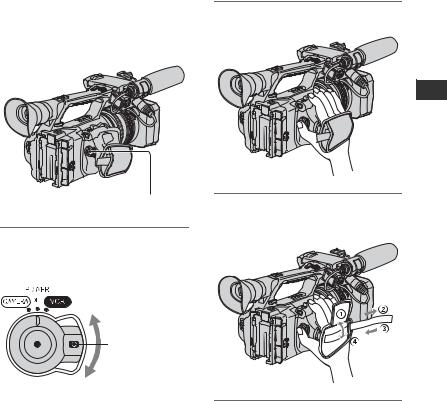
Step 4: Turning the power on and holding your camcorder properly
To record or play back, set the POWER switch to the respective positions.
When you use your camcorder for the first time, the [CLOCK SET] screen appears (p. 20).
2 Hold the camcorder properly.
Started Getting
POWER switch
1 Slide the POWER switch to CAMERA or VCR while you press the green button.
Slide the POWER switch while pressing the green button.
CAMERA: To record pictures.
VCR: To play or edit pictures.
b Notes
•The current date and time appear on the LCD screen for a few seconds when you turn on your camcorder once you set the date and time ([CLOCK SET], p. 20).
3 Ensure a good grip, then fasten the grip belt.
To turn off the power
Slide the POWER switch to OFF while pressing the green button.
b Notes
•If warning messages appear on the screen, follow the instructions.
17
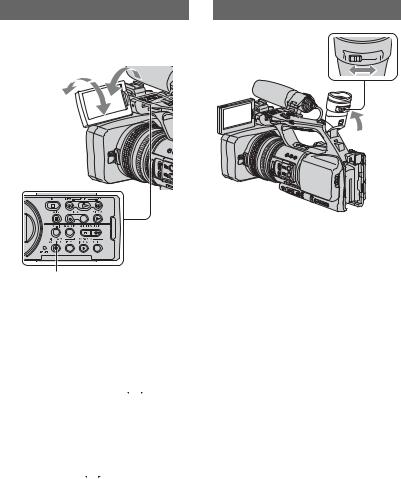
Step 5: Adjusting the LCD panel and viewfinder
The LCD panel
Open the LCD panel 180 degrees (1), then rotate it to the best angle to record or play back (2).
1Open 180 degrees.
290 degrees (max.)
2180 degrees (max.)
DISPLAY/BATT INFO button
z Tips
•You can see your mirror image on the LCD screen by setting the LCD panel facing you. The image will be recorded in a normal image.
To turn off the LCD backlight to make the battery last longer
Press and hold the DISPLAY/BATT INFO button for a few seconds until

 appears. This setting is practical when you use your camcorder in bright conditions or when you want to save battery power. The recorded picture will not be affected by the setting. To turn on the LCD backlight, press and hold the DISPLAY/BATT INFO button for a few seconds until
appears. This setting is practical when you use your camcorder in bright conditions or when you want to save battery power. The recorded picture will not be affected by the setting. To turn on the LCD backlight, press and hold the DISPLAY/BATT INFO button for a few seconds until 

 disappears.
disappears.
z Tips
•You can adjust the brightness of the LCD screen from [LCD BRIGHT] (p. 83).
The viewfinder
Viewfinder lens adjustment lever
Move it until the picture 
 becomes clear.
becomes clear. 
b Notes
•You may see primary colors shimmering in the viewfinder when you move your eye line. This is not a malfunction. The shimmering colors will not be recorded on the recording media.
z Tips
•You can adjust the brightness of the viewfinder backlight from [VF B.LIGHT] (p. 83).
•To display images both on the LCD display and in the viewfinder, set [VF POWERMODE] to [ON](p. 84).
•To display images in black and white in the viewfinder, set [VF COLOR] to [OFF] (p. 84).
18
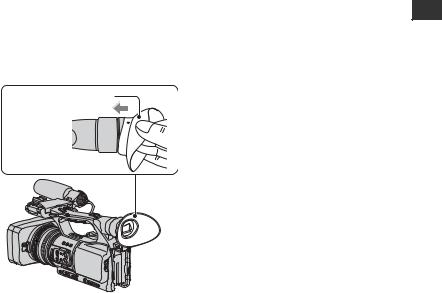
When the picture in the viewfinder is hard to see
If you cannot see the picture in the viewfinder clearly under bright circumstances, use the supplied large eyecup. To attach the large eyecup, stretch it slightly and align it with the eyecup groove in the viewfinder. You can attach the large eyecup facing either the right or left side.
b Notes
• Do not remove the pre-attached eyecup.
Large eyecup (supplied)
Attach with the protruding part at the top.
Started Getting
19
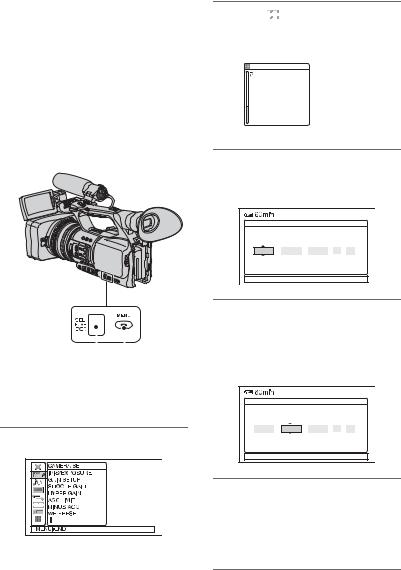
Step 6: Setting the date and time
Set the date and time when using your camcorder for the first time. If you do not set the date and time, [CLOCK SET] screen appears every time you turn on your camcorder or change the POWER switch positions.
z Tips
•If you do not use your camcorder for about 3 months, the built-in rechargeable battery gets discharged and the date and time settings may be cleared from the memory. In that case, charge the rechargeable battery and then set the date and time again (p. 128).
|
|
SEL/PUSH |
MENU |
EXEC dial |
button |
Skip to step 4 when you set the clock for the first time.
1 Press the MENU button.
2 Select 
 (OTHERS) by turning the SEL/PUSH EXEC dial, then press the dial.
(OTHERS) by turning the SEL/PUSH EXEC dial, then press the dial.
|
|
OTHERS |
|
|
|
|
RETURN |
|
|
|
|
CAMERA PROF. |
|
|
|
|
ASSIGN BTN |
|
|
|
|
CLOCK SET |
-- :-- :-- |
|
|
|
WORLD TIME |
|
|
|
|
LANGUAGE |
|
|
|
|
QUICK REC |
|
|
|
|
DATE REC |
|
|
|
|
|
|
|
|
[ MENU ] : END |
|
|
|
|
|
|
|
|
3 Select [CLOCK SET] by turning the SEL/PUSH EXEC dial, then press the dial.
|
|
|
--:--:--:-- |
CLOCK SET |
|
|
|
Y |
M |
D |
|
2008 - |
JAN - |
1 |
12 : 00 AM |
[ MENU ] : CANCEL |
|
|
|
4 Set [Y] (year) by turning the SEL/ PUSH EXEC dial, then press the dial.
You can set any year up to the year 2079.
|
|
|
--:--:--:-- |
CLOCK SET |
|
|
|
Y |
M |
D |
|
2008 - |
JAN - |
1 |
12 : 00 AM |
[ MENU ] : CANCEL |
|
|
|
5 Set [M] (month), [D] (day), hour and minute, then press the dial.
The clock starts.
For midnight, set it to 12:00 AM. For midday, set it to 12:00 PM.
20

z Tips
•The date and time are automatically recorded on the tape, and can be displayed during playback (DATA CODE button, p. 54).
.
Changing the language setting
You can change the on-screen displays to show messages in a specified language. Press the MENU button and select the

 (OTHERS) with the SEL/PUSH EXEC dial. Select the screen language in [LANGUAGE] (p. 93).
(OTHERS) with the SEL/PUSH EXEC dial. Select the screen language in [LANGUAGE] (p. 93).
Started Getting
21

Step 7: Inserting a tape or a “Memory Stick Duo”
Cassette tape
See page 119 for details on tapes including which tapes can be used and how to protect from overwriting tapes.
1 Slide and hold the  OPEN/ EJECT lever in the direction of the arrow and open the lid.
OPEN/ EJECT lever in the direction of the arrow and open the lid.
Lid
OPEN/EJECT lever
The cassette compartment automatically comes out.
2 Insert a cassette with its window facing outwards, then press
 .
.
Window |
Push the center of the back of |
|
the cassette lightly. |
||
|
b Notes
•Do not push the portion marked {DO NOT PUSH} while the cassette
compartment is sliding in. Doing so may cause a malfunction.
3 Close the lid.
z Tips
•The recordable time varies depending on [DV REC MODE] (p. 86). 

To eject the cassette
Open the lid following the same procedure as described in step 1 and remove the cassette.
“Memory Stick Duo”
You can use only a “Memory Stick Duo” marked with 






 ,
,









 or
or










 (p. 122).
(p. 122).
1 Open the “Memory Stick Duo” slot cover in the direction of the arrow.
Cassette |
“Memory Stick Duo” slot cover |
compartment |
|
The cassette compartment automatically slides back in.
22
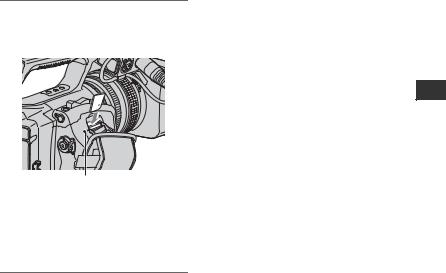
2 Insert the “Memory Stick Duo” into the “Memory Stick Duo” slot in the right direction until it clicks.
Started Getting
Access lamp
b Notes
•If you insert the “Memory Stick Duo” into the slot in the wrong direction, the “Memory Stick Duo,” the “Memory Stick Duo” slot, or image data may be damaged.
To eject a “Memory Stick Duo”
Lightly push the “Memory Stick Duo” once.
b Notes
•When the access lamp is lit or flashing, your camcorder is reading/writing data. Do not shake or knock your camcorder, turn the power off, eject the “Memory Stick Duo,” or remove the battery pack. Otherwise, image data may be damaged.
•When inserting or ejecting the “Memory Stick Duo,” be careful with the “Memory Stick Duo” from popping out and dropping.
23
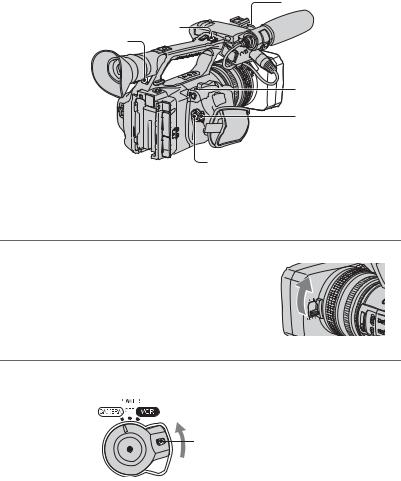
Recording/Playback
Recording
Recording lamp
REC START/
STOP button B
Recording lamp



 Lens hood
Lens hood
ASSIGN 7/
PHOTO button
POWER switch
REC START/STOP button A
Your camcorder records movies on tape and still images on “Memory Stick Duo.” Do the following steps to record movies.
•This camcorder can record movies in HDV or DVCAM (DV) format. The factory setting is HDV format ([REC FORMAT], p. 85).
1 Open the shutter of the lens hood.
2 Slide the POWER switch to CAMERA while pressing the green button.
Press and hold the green button when you slide the POWER switch from OFF.
24

3 Press the REC START/STOP button A (or B).
REC 00:04:50:04 60min 
[STBY] t [REC]
The recording lamp lights up during recording.
To stop the movie recording, press the REC START/STOP button again.
z Tips
•When recording in HDV format, the aspect ratio is fixed to 16:9. When recording in DVCAM (DV) format, you can switch the aspect ratio to 4:3 ([DV WIDE REC], p. 86).
•You can change the screen display during recording (p. 54).
•Indicators displayed on the screen during recording are shown on page 140.
•The recording lamp can be set to stay off ([REC LAMP[F]], [REC LAMP[R]], p. 94).
•You cannot record movies on a “Memory Stick Duo.”
•For low angle recording, the REC START/STOP button on the handle is convenient. Release the HOLD lever to enable the REC START/STOP button. It might be helpful if you set the LCD panel face up or close it after turning it face down, or lift the viewfinder up during the low angle recording.
Recording/Playback
Continued , 25

Recording (Continued)
To capture still images
1Assign [PHOTO] to the ASSIGN 7/ PHOTO button (p. 46).
2Press the ASSIGN 7/PHOTO button or the PHOTO button on the Remote Commander.
A still image will be recorded on the
“Memory Stick Duo.” 






 disappears when the recording is completed.
disappears when the recording is completed.
You can capture still images during movie recording.
z Tips
•See page 142 for indicators that appear on the screen during recording.
•You can assign [PHOTO] to another ASSIGN button from 
 (OTHERS) t [ASSIGN BTN] and use that ASSIGN button as a PHOTO button.
(OTHERS) t [ASSIGN BTN] and use that ASSIGN button as a PHOTO button.
Capacity of the “Memory Stick Duo” (MB) and the number of recordable pictures
|
1.2M |
0.9M |
VGA |
0.2M |
|
1440 × |
1080 × |
640 × |
640 × |
|
810 |
810 |
480 |
360 |
|
1.2M |
|
|
|
512MB |
770 |
1000 |
2900 |
3650 |
|
|
|
|
|
1GB |
1550 |
2100 |
6000 |
7500 |
|
|
|
|
|
2GB |
3150 |
4300 |
12000 |
15000 |
|
|
|
|
|
4GB |
6300 |
8500 |
23500 |
29500 |
|
|
|
|
|
8GB |
12500 |
17000 |
48000 |
60000 |
|
|
|
|
|
16GB |
25500 |
34500 |
97500 |
122000 |
|
|
|
|
|
b Notes
•Specifications are for Sony “Memory Stick Duo.” The actual number of recordable pictures can vary depending on the recording environment and the type of “Memory Stick Duo.”
•You cannot store a still image under the following conditions:
–When [SCAN TYPE] is set to [24] or [24A] and the shutter speed is slower than 1/48 (p. 85, 86)
–When [SCAN TYPE] is set to [60] or [30] and the shutter speed is slower than 1/60
(p. 85, 86)
–While using the fader
–While using [SMTH SLW REC]
–While using shot transition
•The unique pixel array of Sony's ClearVid CMOS sensor and image processing system (Enhanced Imaging Processor) allows for still image resolution equivalent to the sizes described.
z Tips
•Image sizes of still images are as follows:
–Recording in HDV format/DVCAM (DV) format (16:9): 1.2M
–Recording in DVCAM (DV) format (4:3): 0.9M
–Playing back in HDV format: 1.2M
–Playing back in DVCAM (DV) format (16:9): 0.2M
–Playing back in DVCAM (DV) format (4:3): VGA
To store still images captured from movies on a tape on “Memory Stick Duo”
You can capture an image in a movie and record it on a “Memory Stick Duo” as a still image. Be sure to insert a recorded tape and a “Memory Stick Duo” in your camcorder.
1Assign [PHOTO] to the ASSIGN 7/ PHOTO button (p. 46).
2 Set the POWER switch to VCR.
3Press the N (play) button to search for the scene you want to save as a still image. Press the ASSIGN 7/PHOTO button or the PHOTO button on your Remote Commander at the scene.
b Notes
•The recorded date and time on the tape and the stored date and time on the “Memory Stick Duo” are both saved on the “Memory Stick Duo.” When you view the still images, only the recorded date and time on the tape will be displayed on the screen (Data code, p. 54).
26

•Camera data stored on the tape will not be copied to the “Memory Stick Duo.”
•You cannot store a still image during using your camcorder with [PB ZOOM] set to [ON] (p. 93).
Recording/Playback
27

Changing the settings of your camcorder recordings
Adjusting the zoom
.
Using the zoom lever
Move the power zoom lever D slightly for a slower zoom. Move it further for a faster zoom.
Wide view: (Wide angle)
•You can increase the zoom speed of the zoom lever D or the handle zoom A ([SPEED ZOOM], p. 73).
Using the handle zoom
1Set the handle zoom switch B to VAR or FIX.
z Tips
•When you set the handle zoom switch B to VAR, you can zoom in or out at variable speed.
•When you set the handle zoom switch B to FIX, you can zoom in or out at fixed speed set in [HANDLE ZOOM] (p. 73).
2Press the handle zoom lever A to zoom in or out.
b Notes
•You cannot use the handle zoom lever A when the handle zoom switch B is set to OFF.
•You cannot change the zoom speed of the zoom lever D with the handle zoom switch B.
Close view: (Telephoto)
z Tips
•The minimum distance required between your camcorder and the subject for focus is about 1 cm (about 13/32 in.) for wide angle and about 80 cm (about 2 5/8 feet) for telephoto.
•The focus may not be adjusted at certain zoom positions if the subject is within 80 cm (about 2 5/8 feet) from your camcorder.
•When you set [FOCUS MACRO] to [OFF], you cannot focus on a subject within 80 cm (about 2 5/8 feet) regardless of the zoom position (p. 73).
•Be sure to keep your finger on the power zoom lever D. If you move your finger off the power zoom lever D, the operation sound of the power zoom lever D may also be recorded.
Using the zoom ring
You can zoom at the desired speed by turning the zoom ring C. Fine adjustment is also possible.
b Notes
•Turn the zoom ring C at a moderate speed. If you turn it too fast, the zoom speed may lag behind the zoom ring rotation speed, or the operation sound of the zoom may also be recorded.
28
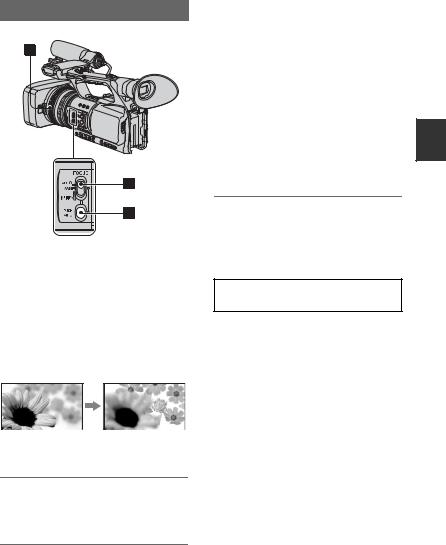
Adjusting the focus manually
You can adjust the focus manually for different recording conditions.
Use this function in the following cases.
–To record a subject behind a window covered with raindrops.
–To record horizontal stripes.
–To record a subject with little contrast between the subject and its background.
–When you want to focus on a subject in the background.
– To record a stationary subject using a tripod.
1 During recording or standby, set the FOCUS switch B to MAN.
9 appears.
2 Rotate the focus ring A and adjust the focus.
9 changes to  when the focus cannot be adjusted any farther. 9 changes to
when the focus cannot be adjusted any farther. 9 changes to  when the focus cannot be adjusted any closer.
when the focus cannot be adjusted any closer.
z Tips
For focusing manually
•It is easier to focus on the subject when you use the zoom function. Move the power zoom lever towards T (telephoto) to adjust the focus, and then, towards W (wide angle) to adjust the zoom for recording.
•When you want to record a close-up image of a subject, move the power zoom lever towards W (wide angle) to fully magnify the image, then adjust the focus.
To restore automatic adjustment
Set the FOCUS switch B to AUTO. 9 disappears and the automatic focus adjustment is restored.
Using automatic focus temporarily (Push auto focus)
Record the subject while pressing and holding the PUSH AUTO button C.
If you release the button, the setting returns to manual focusing.
Use this function to shift the focus on one subject to another. The scenes will shift smoothly.
z Tips
•The focal distance information (for when it is dark and hard to adjust the focus) appears for about 3 seconds in the following cases. (It will not be displayed correctly if you are using a conversion lens (optional)).
–When you set the FOCUS switch to MAN and 9 appears on the screen
–When you rotate the focus ring while 9 is displayed on the screen.
Recording/Playback
Continued , 29

Changing the settings of your camcorder recordings (Continued)
Using the expanded focus (Expanded focus)
Assign [EXP.FOCUS] to any one of the ASSIGN buttons beforehand (p. 46). During standby, press the ASSIGN button to which [EXP.FOCUS] is assigned. [EXPANDED FOCUS] appears and the center of the screen is magnified by about 2.0 times. It will be easier to confirm the focus setting during manual focusing. The screen returns to the original size when you press the button again.
b Notes
•The screen returns to the original size when you start recording during the expanded focus display.
z Tips
•You can select a type of an expanded image displayed during the expanded focus ([EXP.FOCUS TYPE], p. 82).
Focusing on a distant subject (Focus infinity)
Slide the FOCUS switch B to INFINITY and hold it there.
 appears on the screen.
appears on the screen.
To return to manual focus mode, release the FOCUS switch B. This function enables you to set focus on a distant subject even when the focus is automatically set on a close subject.
b Notes
•This function is only available during the manual focus. It is not available during the automatic focus.
Adjusting the image brightness
You can adjust the image brightness by adjusting the iris, gain or shutter speed, or by reducing the light volume with the ND filter B. Also, when [EXPOSURE] is assigned to the iris ring A, you can adjust the iris, gain and shutter speed with the iris ring A. You can assign [IRIS] or [EXPOSURE] to the iris ring A from [IRIS/EXPOSURE] of the 



 (CAMERA SET) menu (p. 69). The default setting is [IRIS].
(CAMERA SET) menu (p. 69). The default setting is [IRIS].
b Notes
•You cannot use the back light function and the spotlight function if at least two of iris, gain and shutter speed are adjusted manually.
•[AE SHIFT] is not effective while you adjust the iris, gain and shutter speed all manually.
Adjusting the iris
You can manually adjust the iris to control the volume of the light entering the lens. By adjusting the iris, you can change or close the aperture of the lens, which is expressed as an F value between F1.6 and F11. The volume of the light increases the more that you open the aperture (decreasing F value).
30
